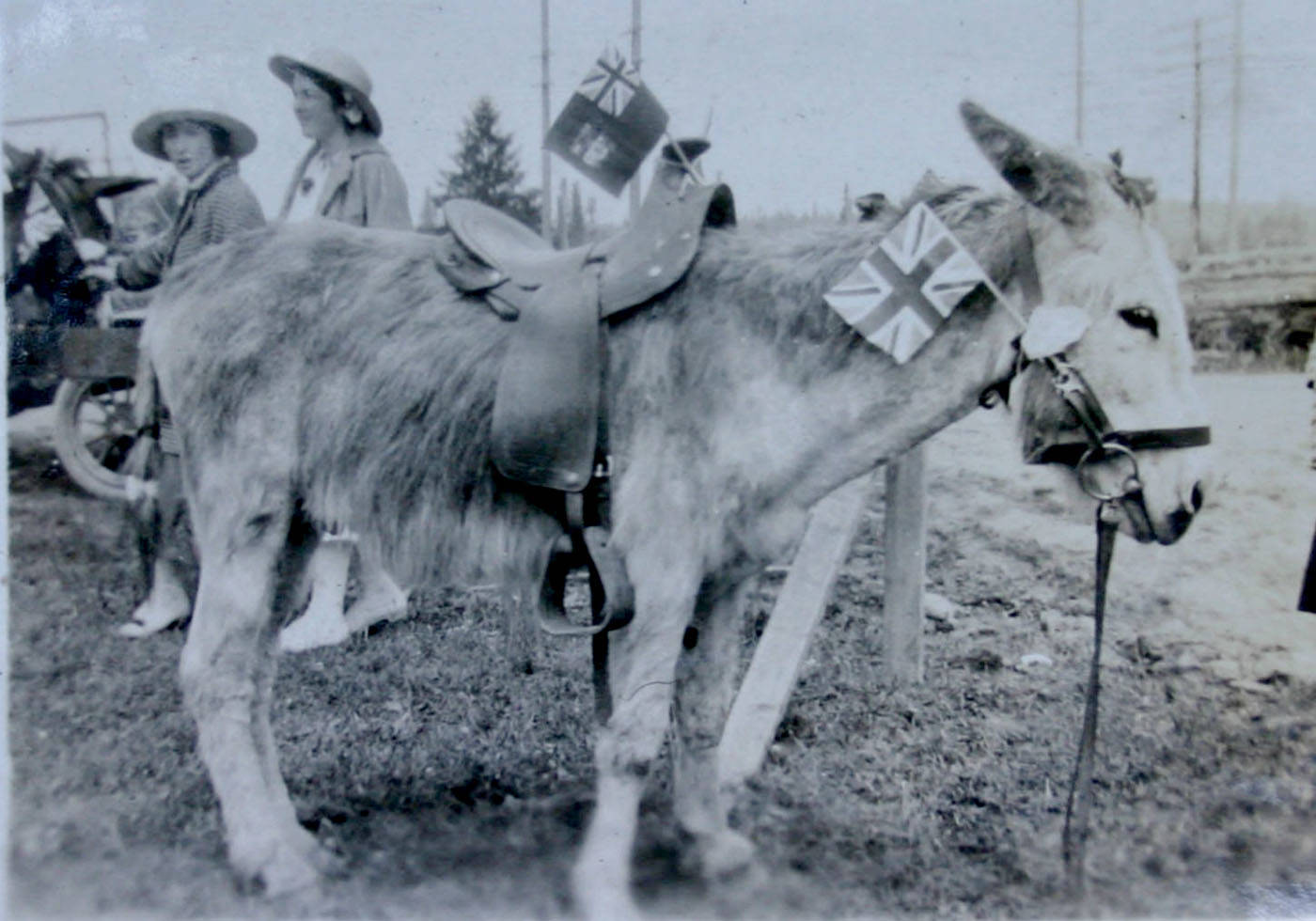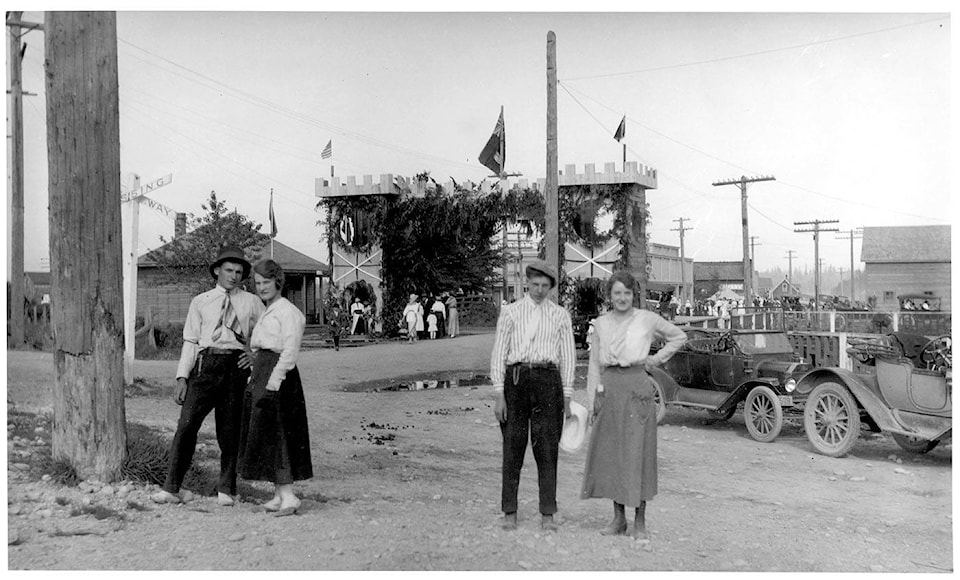When the residents of Langley gathered to celebrate the 1st of July in 1917, the community was a far different place than it is today: heavily forested, sparsely populated, and lacking most of the infrastructure and amenities that we now take for granted.
There were no paved roads, street lights, or sidewalks.
In the absence of a municipally-provided supply, residents drew their water directly from wells or streams. Few homes enjoyed the luxury of either electricity or a telephone, while indoor plumbing was all but unknown. Even so, considerable progress had been made in “taming the wilderness” as families of predominantly European origin established homes, farms, and businesses in what they considered a new land.
As the 50th anniversary of Canadian Confederation approached, few in Langley gave much thought to the Native people who had been systematically displaced to make way for a predominantly European society. Instead, the Dominion Day holiday (as Canada Day was then known) would celebrate the nation’s largely British heritage and reaffirm the small community’s resolve to continue the struggle against a brutal enemy far across the Atlantic Ocean.
The First World War had been underway for almost three years and would go on for an additional year and a half.
By the time the conflict was over close to 400 Langley residents – about half the adult male population – would don a military uniform, the vast majority of them serving with the Canadian forces on the Western Front.
Dominion Day would prove to be a bittersweet affair as families pondered absent fathers, sons, and husbands, 15 of whom had already been killed in the shell-pocked fields of France and Flanders. Another two-dozen local men would suffer a similar fate before the war finally ground to a halt.
Despite the dark cloud hanging over the impending holiday, Langley residents were resolved, in the words of contemporary songwriter Ivor Novello, to find a silver lining.
The success of the Canadian Corps at the Battle of Vimy Ridge in April had elicited considerable pride across the country and heightened Canadians’ growing sense of national identity.
The impending anniversary of Confederation thus offered the community an opportunity to come together, forget the suffering, and celebrate the nation’s successes. .
Early in the war the community had rallied to provide financial assistance to families whose wage-earners were then serving overseas. In the months and years that followed, residents of Langley also provided the men in the trenches with box after box of socks, scarves, tobacco, and baking to supplement their modest military rations.
In the early summer of 1917 several of the community leaders who had led these efforts began to plan what may well have been the largest celebration that Langley had ever seen.
Chaired by Reeve (mayor) Robert Wark, an organizing committee comprising gentleman farmer Brian Harrison, school principal Philip Sheffield, businessman Edward Timms, and shopkeepers Henry Johnston and P.Y. Porter chose Langley Prairie (today’s City of Langley) as the site of the event. Insofar as there were no parks in Langley Prairie or anywhere else in the municipality, the committee elected to hold the celebrations on the village’s main street and on a number of adjacent vacant lots.
In 1917, a number of village centres (including Fort Langley, Milner, Murrayville, and Aldergrove) vied with Langley Prairie to become “downtown” Langley. Located at the intersection of the Yale Road (today’s Fraser Highway), the Langley Trunk Road (now Glover Road), the McLellan Road (now 56th Avenue), and the British Columbia Electric Railway, however, it was the emerging settlement of Langley Prairie that would become the heart of the municipality.
Part of Langley Prairie’s recent success was due in large measure to the efforts of entrepreneurs George Young Timms and his son Edward.
Not only had the two men and their extended family built a large complex of commercial greenhouses on what is today the site of the Langley Mall, they had also erected a series of mercantile buildings – including a theatre, office block, and hotel – on the north side of the Yale Road.
In time the Timms Market Garden (later re-named the Langley Greenhouses) would become one of the largest wholesale flower producers on the continent.
In addition to having a sound talent for business, the Timms family was also remarkably artistic. Edward Timms’s brother Philip was not only one of Vancouver’s most accomplished professional photographers; he was also his church’s choirmaster. Another brother, Arthur, operated a successful print shop, while a third, Vivian, was an aspiring painter. Others in the family had a talent for music. Edward’s father George was a competent cellist and horn player, while several female members of the family were capable singers and pianists.
With such a body of talent at his disposal, it was only natural for Edward Timms to be chosen to co-ordinate the entertainment for the Dominion Day celebrations.
Edward’s plans for the event were nothing if not ambitious, so much so that the organizing committee convinced the B.C. Electric Railway to lay on a special train to carry an anticipated crowd of visitors to Langley from Vancouver, then return them back to the city after midnight.
When the long-anticipated day finally dawned the weather was perfect: sunny but not too warm. Visitors arriving by train were greeted by the large wooden arch that residents had built across the road. Resembling a medieval English castle gate, the crenelated structure was heavily draped with cedar boughs and Union Jacks, while Canada’s own red ensign flew proudly from its centre.
The normally sleepy hamlet was abuzz with excitement. There was music in the air and the tents and marquees erected earlier in the morning had begun to attract an enthusiastic crowd.
The festival’s organizers had worked hard to ensure that there would be events for all ages and interests. A parade of colourful floats from schools throughout the municipality launched the day’s festivities. An energy-charged baseball game followed, the Langley Prairie team being pitted against one assembled by the railway company.
After a break for lunch (some of the refreshments having been prepared by a group of community women) a variety of carnival rides, games, and races ensured that the children in attendance would be kept well amused.
For some of the children, the donkey races may well have been the highlight of the day. A few lucky youngsters, like Reeve Wark’s daughters Dorothy and Mary, were able to take one home for the afternoon. The borrowed animal, however, had a mind of its own. As Mary recalled some 85 years later:
“There were booths of many kinds, a merry-go-round and pony and donkey rides. I loved any animal resembling a horse and my parents hired a donkey for us to take home for the afternoon. He was a kindly animal, both amiable and determined. He graciously accepted our pats, hugs, and carrots, but once my sister was aboard for the first ride, he set out for the friends he had left behind. No amount of coaxing or pulling on the reins could persuade him to stay on our farm! He plodded relentlessly on to join them.”
For the adults in attendance, the afternoon afforded a pony race, “Ford auto races,” foot races, a second baseball game, a tie-making contest, and a “tug-of-war tournament.” At a time when the entire municipality had less than a dozen cars to its name, the Ford auto races (presumably held on the village’s gravel-surfaced main street) must have been a riveting spectacle.
The band concert held that afternoon featured a strong Timms family presence as conductor Edward Timms led Langley’s own band and Vancouver’s Elks Lodge Band in a 90-minute program of waltzes, overtures, marches, and sentimental favourites. Renditions of tunes such as “Keep the Home Fires Burning,” “On to Victory,” “Our Allies,” and “We’ll Never Let the Old Flag Fall” served as a poignant reminder of loved ones serving overseas while strengthening the community’s resolve to secure the final victory.
The festivities might easily have ended then, but there was still more to come. An evening vaudeville program began in the early evening. Held in the Timms family’s Langley Theatre, the concert opened with Edward’s wife Annie singing the patriotic anthem “Rule! Britannia,” one of the most popular tunes of the day. Concertinist Henry Fray, a musician brought in from Vancouver, followed with a rousing “Medley of Patriotic Airs,” while local farmer and realtor E.J. Wilson offered up an inimitable impression of Harry Lauder, the legendary Scottish singer and comedian.
The evening’s entertainment continued with songs from additional soloists, concluding with a production of the comedic farce, “The Hitching of Twitchet.” Members of the Timms family figured prominently in the cast; Madge, Philip, and Edward Timms joined members of the Skuce and Penzer families in taking to the stage, either as singers or actors, in the second half of the program.
The vaudeville show ended about 9:30 p.m., but the day was not yet over. As the theatre’s benches were moved to the side, men and women assembled for the evening’s finale, a “Grand Ball” organized by Philip Sheffield, principal of the Belmont Superior School, the Murrayville-based predecessor of the Langley High School. The dance was apparently an alcohol-free event, the community being in the midst of a public debate on prohibition, and Langley Prairie lacking either a liquor store or a licensed hotel.
When the clocks finally struck midnight, the exhausted but happy revellers said their good-byes and set out for home. In the days that followed reports in the press advised that Dominion Day in Langley had been celebrated “in royal style, with sports, speeches, music, and dancing.”
Over $1,000 had been raised “for patriotic purposes,” such as the Canadian Red Cross and the Canadian Patriotic Fund. The fact that the Langley Prairie baseball team had defeated two teams from New Westminster – the “Electrics” in the morning and the “Druggists” in the afternoon – had been the icing on the cake.
•••
Langley Times contributor Warren Sommer is the author of Canucks in Khaki: Langley, the Lower Mainland, and the Great War of 1914 to 1918 and guest curator of the exhibition Sacrifice and Sorrow: Langley and the Great War, currently on display at the Langley Centennial Museum

